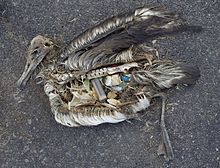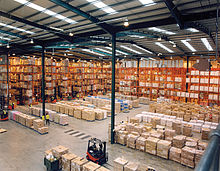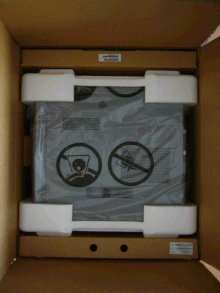packaging

A packaging generally refers to the sheath or (partial or full) wrapping an object, in particular for its protection or for better handling. At the same time, the term also describes the process of packing or being packed.
In the context of trade and production, the term is related to the packaging of products: Here is a package (in the merchant language also Emballage called) which specifically mounted, again preferably detachable without much effort wrapping a product. The wrapping can be done partially or completely. A distinction is made between the direct packaging of a product, the primary packaging, and the outer packaging or collective packaging, which is also referred to as secondary packaging.
The item to be packed is called the packaged goods , the fully packed product is the package . Several packages of the same packaged good form a collective package . The term pack can be synonymous with packaging as well as the entirety of packaged goods with packaging. As a branch of the economy , one speaks more generally today of packaging , from materials science to production and transport logistics.
Certain products such as bulk goods , liquids or gases are packed in suitable containers ( tubes , buckets , bottles , boxes or cans ). These products become piece goods through packaging .
Many products, especially food, cannot be stored, distributed or sold without proper packaging. A packaging forms a logistic unit ( unit load , see glossary of logistics ) from one or more product units and thus supports the respective process processes in logistics and retail .
Packaging and packaging systems are available as reusable and disposable versions . Disposable packaging is made for single use only. Reusable packaging is used multiple times, i. H. emptied and refilled after transport / sale / use. A group of reusable systems are deposit schemes .
Types of packaging
Gift wrapping
Gift packaging visually enhances an item in order to express the appreciation shown by the giver to the recipient of a gift . Additional decorations are usually used for gift packaging. The shapes and colors used depend on the occasion. An important factor in gift packaging is often the conscious concealment of the gift, so that the gift item remains hidden and so the unpacking also brings a surprise.
Retail packaging
Sales packaging supports the shelf life of goods and protects them on the way from retail to the end consumer. In addition, packaging can provide additional services through its spatial or color design and as a carrier of informative labels and images.
Service packaging
Service packaging is a special form of sales packaging. Service packaging is only added during the sales process to the end customer / end user at the point of sale of the goods in order to enable or support the handover of the goods. Examples are bags made of paper or plastic ( plastic bags ).
Outer packaging
The outer packaging (outer box) encloses the sales packaging as a second layer with additional protective functions.
Retail packaging
Retail packaging is an outer packaging that is intended for retail sale in stores (retail version). In addition to their protective function, retail packaging has other functions, such as providing an area for information or advertising messages.
Transport packaging
Transport packaging is used exclusively to transport the goods, e.g. B. Transport pallets , stretch films and strapping .
Bulk
In a bulk - or Original Equipment Manufacturer ( OEM ) -packaging (. English to German OEM packaging ) usually a single article is part of a larger packaging unit without contain a separate outer packaging. This is a wholesale packaging of a manufacturer of finished components or products that have been produced in his own factories, but are not sold individually by him, but are distributed in larger collection units via wholesale stations,
Functions of packaging
protection
Packaging is primarily intended to protect the goods themselves from environmental influences, damage, contamination and (quantitative) loss. In addition, it also protects the people handling the material from injuries, e.g. B. with sharp-edged, pointed or poisonous objects. Furthermore, the means of transport, the environment and other goods are protected from damage, for example by leaking liquids. Another aspect is the preservation of food, for example through airtight or empty packaging. The use of aseptic filling techniques, sterile filling, protective gas or vacuum packaging are common methods.
Appropriate packaging design (closures, seals, prepackages ) can also provide greater protection against manipulation and theft.
Conceal and surprise effect
Especially with gift packaging, the conscious concealment of the gift is an important function, so that the gift item remains hidden and so the unpacking also brings a surprise.
Functions in sales and in use by the end user
Dosing or withdrawal

Many packaged goods are dosed for the intended end use by means of their packaging. The packaging contains or is itself an aid for appropriate dosing (lids of cleaning agent bottles; small measuring containers in washing powder cartons ). Food is also often taken directly from packaging and consumed (beer bottle, chocolate bar, ice cream).
communication
Nowadays more than ever, the decision in favor of a certain packaging serves to identify a product on the market as quickly and easily as possible, rememberable and sustainable. It must convey the so-called personality of the product and the brand concerned and, above all, serves to differentiate it from competing products. Conveying an additional benefit ( Unique Selling Proposition ) is another important communication function of product packaging.
information
The packaging identifies the product according to type, quantity, weight and price, provides information on dangerous goods information, expiry dates or best before dates (BBD) and intended use, and is also the carrier of coded data ( barcodes ). For example, the imprint of allowing European Article Number ( EAN Code ) (engl., Dt. European Article Number ) rapid reading at a checkout scanner .
advertising
The buyer can recognize a product through the sales packaging , be it by the name, the company logo used or the color or shape of the packaging. An appealing sales packaging can promote the sale and thus the sales of a product, thus increasing the revenue and, with a correspondingly positive calculation, also the profit of the respective seller. In addition, it can win new customers, which in turn can increase the revenues and thus possibly also the profit again. As a rule, sales packaging conveys the first impression that is decisive for the purchase .
Deception: sham packaging
The so-called sham packaging represents a special case of the combination of product and packaging : here, the appearance of the packaging simulates a different, better or greater use of the packaged product than it actually provides. Fraudulent packaging is prohibited by law in Germany and many other countries ( consumer protection ).
rationalization
Modern self-service systems could only achieve their upswing and now dominant position through the use of new packaging methods as an aid to rationalize the sales process. At a meat counter, for example, there is no need to weigh and pack the desired goods if they have already been packed, weighed and labeled at another location or on another occasion and are then displayed for self-service .
Jewelry, special edition

Jewelery packaging can increase the number of sales of the packaged product through an attractive and possibly only made and available presentation ( special edition ) for a certain time or in a limited number / edition .
Functions of packaging in logistics
storage
As a rule, every product is stored or relocated several times from the time of manufacture to the time of use or consumption. Storage at the manufacturer , importer , wholesaler and retailer, carrier or warehouse keeper as well as at the consumer is possible. With the help of suitable packaging, goods or products can be stored more easily, safely and quickly.
transport
During transport, the transport packaging should prevent the goods from being exposed to excessive mechanical loads (vibrations, shocks). This can be done through multiple protection ( cardboard box , transport pallet ). Standardized packaging means that less space is required on the means of transport . Standardization can even go so far that the dimensions of the packaging (e.g. pallets or lattice boxes ) are precisely matched to the dimensions of the means of transport, thus leading to optimal utilization of the means of transport and accelerating the loading and unloading process. These facts are mapped in the FREP model.
Additional benefit
Comfort
Ease of use, stackability on pallets and the ability to display packaging in the trade in a simple manner and with the least possible additional effort are summarized in the term of the convenience performance contained in the packaging . This service as well as an information and sales service of packaging that may also be included is also referred to as convenience .
Re-use
Often sales packaging offers an additional benefit in the form of its possible further use after consumption or the removal of the product previously contained therein. This often has no relation to the purchased goods themselves. An example is a mustard glass with the shape of the packaging as a drinking glass. Such packaging is usually intended to act as an incentive to buy, in that the buyers prefer a certain product because they already have an eye on the further use of the packaging. This can be referred to as so-called " upcycling ".
Manufacturing
Packaging can consist of different materials. The most common are glass , sheet metal , plastic and cardboard . Plastic can appear as molded parts or as a plastic film . There are two different methods of manufacturing rigid plastic packaging: injection molding and thermoforming . Cardboard packaging ( cardboard packaging ) is created using the punching process .
Components
A distinction is made between two components in packaging technology.
Packaging
The packaging is the main component of packaging. With it, the packaged goods are partially or completely enclosed or combined.
Packaging aids
The auxiliary packaging means is used primarily to a package to be closed (as with an adhesive tape ) or bolster (about with foam , paper , Luftpolstertaschen ). Thus, as the packaging of the contents of a bottle from its bottle body as packaging material and its cap, formed as a crown cork , cork or screw cap as sealing its opening and the label as packaging aids.
Packaging materials
The materials from which packaging is made are called packaging materials . Typical packaging materials are paper, plastic, wood , metal ( tinplate , aluminum ) or glass. Corrugated cardboard packaging is also called cardboard packaging .
Absolutely airtight and chlorine-free packaging for food and drugs made from graphene is currently being tested. This enables packaging to be produced without the chlorine-containing, harmful polymers, and the flavor of food in graphene packaging is completely retained.
Recycling, ecology

Packaging pollutes the environment through production and disposal. Various types of packaging have therefore often been examined in a life cycle assessment . It has been shown that it often does not make sense to assess or compare packaging based on its material. Rather, it is necessary to examine the packaging in connection with its functions and also to take into account in the life cycle assessment that different types of packaging can also have an impact on the shelf life of the product or on sales losses.
Packaging that has already been used, regardless of whether it is intended for one-time or multiple use, is generally not considered waste in Germany, but as a valuable material , the disposal, recycling and reuse of which is regulated in the Packaging Ordinance.
Disposable
Disposable packaging from private households that is marked with the Green Dot is fed into a material cycle (material recycling) or incinerated (thermal recycling) as part of the so-called dual system Germany .
Reusable
Reusable packaging generally takes part in loan and return transactions and is often given in return for a deposit (Swiss: depot ). The most famous reusable packaging is the reusable bottle . Since 2003, a deposit has also been mandatory in Germany for beverages sold in one-way packaging.
In the transport sector , standardized reusable pallets (e.g. Europool pallets ) are exchanged upon delivery or delivery.
Compostable
Packaging made from compostable materials is an alternative to conventional packaging materials that can often no longer be used and thus become waste after use. They are made from biodegradable plastics and consist partly or completely of renewable raw materials such as starch , cellulose or polylactic acid . These plastics are suitable as packaging materials for various products, for example food. Many of these packaging made from sustainable raw materials can be used to the same extent as their petroleum-based equivalents and are therefore suitable for use in ovens, microwaves and refrigerators.
Packaging industry
The industry is highly fragmented, as the individual sub-sectors - paper , cardboard, cardboard ( corrugated cardboard ), plastic, metal ( tinplate ), container glass and wood - sometimes differ significantly from one another. The packaging industry in Germany was able to increase its sales by around 40% from 1996 to 2009. The number of employees fell to 115,685 in the same period. In 2012, the industry's turnover was 29.7 billion euros; in 2014 there were 1,144 companies with 135,117 employees.
Paper industry
In 2014, the paper packaging industry generated around 46% of the total turnover in the German packaging industry.
In 2012, global paper packaging industry revenues were $ 354.2 billion. At the time, the largest in the paper industry included Kimberly-Clark , NewPage Corporation, International Paper , Svenska Cellulosa and Stora Enso , although the product range mentioned is not usually limited to packaging.
Paper and film producers are industry association organizes paper and film packaging eV. The German Packaging Institute dvi describes itself as the network of the packaging industry . A complete list of all industry associations can be found on the DVI website.
Food packaging
One of the largest branches of industry is the food industry , which is largely based on food packaging . Euromonitor International estimates that this industry is worth $ 1.6 trillion.
National regulations
Germany
Until the end of 2018, the Packaging Ordinance applied in Germany , which, among other things, regulated participation in return systems for sales packaging .
On January 1, 2019, the "Law on the placing on the market, return and high-quality recycling of packaging" - Packaging Act (VerpackG) came into force. In Germany, it replaces the packaging regulations that were in effect until then. The law applies to everyone who brings packaging filled with goods, including filling materials, into circulation. Among other things, a registration requirement and a data reporting requirement were introduced.
Austria
Since October 1, 1993, the Ordinance on Avoiding Packaging Waste (Packaging Ordinance) has been in force for all packaging and packaging waste that has been placed on the market in Austria, regardless of whether it was generated in private households or in the commercial sector.
See also
Web links
- German Packaging Museum
- Ina Bockholt: Packaging waste: How much waste can be avoided? An experiment. In: test (magazine) . October 11, 2019 .
literature
- Heinrich Martin: Transport and warehouse logistics. Vieweg, Braunschweig / Wiesbaden 2000, ISBN 3-528-24941-2
- Thomas Krieg, Sylvia Walther (illustrations): Packed and sealed. rokoko-Netzwerk für Kommunikation Dortmund on behalf of ratioform Verpackungen GmbH, Pliening-Landsham 2004, ISBN 3-00-013011-X
- Harald Seeger: Practice Book Packaging. How packaging design sells products. mi-Wirtschaftsbuch, Munich 2009, ISBN 978-3-86880-010-4 .
- Gavin Ambrose, Paul Harris: This end up- creative packaging design . Stiebner, Munich 2003, ISBN 978-3-8307-1287-9 .
- Günter Bleisch, Horst Goldhahn, Gerhard Schricker, Helmut Vogt: Lexicon packaging technology. Hamburg 2006, ISBN 978-3-89947-326-1
Individual evidence
- ^ Günter Bleisch, Horst Goldhahn, Gerhard Schricker, Helmut Vogt: Lexicon packaging technology. Hamburg 2006, ISBN 978-3-89947-326-1 .
- ↑ News on testing alternative packaging materials. In: medewo.com , accessed on July 4, 2012.
- ↑ The influence of packaging on the life cycle of products. ( Memento from March 18, 2009 in the Internet Archive ) In: esu-services.ch
- ↑ packaging. Retrieved December 21, 2019 .
- ↑ Industry report packaging industry Germany. In: IG Metall . 2010, accessed June 2, 2017 .
- ↑ Industry data. Hauptverband Papier- und Kunststoffverarbeitung (HPV) eV, accessed on August 1, 2016 (according to the association's career portal).
- ↑ de.statista.com
- ↑ Global Forest, Paper & Packaging Industry Survey: 2013 edition - survey of 2012 results . PwC . 2013.
- ↑ ipv-verpackung.de
- ↑ verpackung.org German Packaging Institute
- ↑ Left. In : paket.org
- ^ The World's Biggest Industry . forbes.com .
- ↑ https://www.bgbl.de/xaver/bgbl/start.xav?start=//*%5b@attr_id=%27%27%5d#__bgbl__%2F%2F*%5B%40attr_id%3D%27bgbl117s2234 .pdf% 27% 5D__1499860922556 Federal Law Gazette 2017 Part I No. 45, issued in Bonn on July 12, 2017
- ↑ https://verpackungsgesetz-info.de/wp-content/uploads/2018/06/20171019_landbell_verpackg-factsheet_de_final.pdf Information sheet on the Packaging Act, accessed on January 10, 2020









